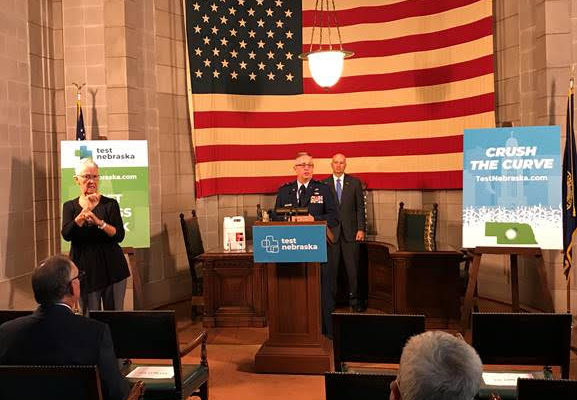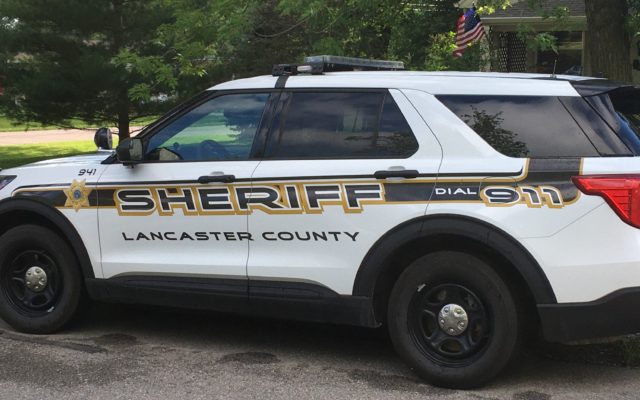Governor And State Agencies Announce Creation of Incident Management Team

(KFOR NEWS September 10, 2020) On Wednesday, Governor Pete Ricketts and Major General Daryl Bohac, Director of the Nebraska Emergency Management Agency (NEMA), announced that, for the first time in its history, the State of Nebraska has a fully operational Type 3, All-Hazards Incident Management Team (IMT).
NEMA Assistant Director Bryan Tuma, State Fire Marshal Chris Cantrell, and Nebraska Forest Service Director John Erixson joined the Governor and Maj. Gen. Bohac for the announcement.
“This new Incident Management Team is helping better coordinate Nebraskans to provide leadership during extended emergencies including wildfires, floods, and other disasters,” said Gov. Ricketts. “When communities face challenges beyond the capabilities of local responders, Nebraska’s qualified Incident Management Team can provide support to help protect communities and bring in additional resources.”
An IMT works at the scene of a disaster to coordinate a response along with the State Emergency Operations Center at NEMA and federal partners, if needed, to secure resources and personnel that exceed a local jurisdiction’s capabilities to respond to a wildfire or other disaster.
“The IMT demonstrates our continued commitment to building and maintaining strong partnerships for the benefit of the people of Nebraska,” Maj. Gen. Bohac said. “Development of partnerships from the federal, state, to local level are an effective and efficient way to respond to all disasters.”
Once a local jurisdiction declares an emergency, a state declaration must be approved by Gov. Ricketts to allow state resources to be made available to aid in the response. Previously, state resources would provide assistance to local emergency managers during a disaster. With the new IMT in place, local jurisdictions can now request for the State to directly manage the disaster response.
A Type 3 IMT includes a minimum of eight command and general staff members who manage an incident after being delegated authority by a local jurisdiction faced with a disaster that exceeds its capabilities and resources. An Incident Management Assistance Team (IMAT) includes credentialed members who deploy as needed to integrate with local responders to assist them in managing their incident.
Team members can include trained command, operations, planning, logistics, and finance/administration personnel from different state agencies, fire departments, and local emergency management who work together within the confines of the Incident Command System (ICS). ICS is part of the National Incident Management System which allows the whole community to work together to manage all threats and hazards regardless of cause, size, location, or complexity.
Team activation is requested through local emergency managers to the Nebraska Emergency Management Agency. Under the Nebraska Emergency Management Act, an IMT or IMAT in Nebraska deploys as a State Emergency Response Team (SERT) under the authority of The Adjutant General of the Nebraska Military Department.
State Fire Marshal Chris Cantrell said the State made the choice to support responders and citizens of Nebraska with development of an IMT/IMAT because of lessons learned from previous large wildland fires.
“The support this team brings to firefighters, emergency management, local jurisdictions, and the citizens of this state is essential,” Cantrell said. “A Type 3 team can provide relief to local jurisdictions when an incident increases in complexity, and can also help to get control of an incident before it becomes too complex, such as a Type 2 or Type 1 incident. The transition from a local incident management to a mid-level management has never been an option in our state before. This is a major milestone towards Nebraska being capable of assisting its citizens in their greatest time of need.”
“Fires are just one of the reasons an IMT or IMAT would be deployed,” NEMA Assistant Director Bryan Tuma said. “The team can assist with incident management activities during all-hazards events, including natural and human-caused events, as well as planned events.”
“Having a state IMT is a cost-effective way to respond to incidents,” State Forester John Erixson said. “Cost of a national Type 1 and Type 2 team is considerably higher than that of a Type 3 team.”
Nationally, there are five types of IMTs:
- Type 5: A local village and township team composed primarily of fire officers from neighboring departments trained to serve in command and general staff positions during the first 6–12 hours of an incident.
- Type 4: A city, county, or fire district including fire, EMS, and law enforcement officers from a larger and generally more populated area during the first 6–12 hours of an incident.
- Type 3: A state or metropolitan area team comprised of several entities within a state or region, activated to support incident management at incidents of extended duration.
- Type 2: National and state teams used on smaller-scale national or state incidents.
- Type 1: The most robust IMT with the most training and experience. These teams operate through interagency cooperation of federal, state, and local land and emergency management agencies.
READ MORE: Lincoln Fire And Rescue Hosts Virtual Patriot Day Ceremony






